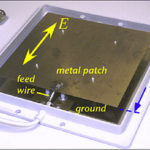Passive RFID tags have been widely adopted, and some applications show creative adaptation to unmet needs.
It’s interesting to see how advances in technology often are adapted to applications that were not highlighted in their original “use case” scenarios and how clever people adapt or leverage new technologies in unscripted ways. A good example of this phenomenon is radio frequency identification (RFID), where wireless tags, both unpowered (passive) ones and battery-powered (active) ones, have found uses that are both innovative and clever.
What is an RFID tag? It’s a small, thin, flat tag with an integral electronics assembly that contains an identity code and perhaps some additional data. It is interrogated and read by a non-contact reader at a distance of a few centimeters to several meters, depending on the tag type, design, frequency, and operating environment.
Due to their low cost, long life, and small size, passive tags are often used for a general category called “asset tracking.” Among the original applications foreseen by passive RFID advocates were the replacement of bar codes on grocery packages (didn’t happen) and in warehouses (lots of adoption there), non-contact personal ID cards for employees (also widely used), and wireless readers for credit cards and other financial cards (again, widespread adoption). In some cases, passive RFID would replace optical bar-code scanners; in others, it would replace physical contact and swipe.
Note that active tags offer a very different story and application set. For example, they are now embedded in professional soccer balls and footballs, and even the players, to precisely track their location and movement to centimeter accuracy in real-time. This requires interrogation rates and updates in the kilohertz range to provide the desired accuracy. While these uses are dramatic, they are relatively costly in both systems support and the tags, as the tag must be replaced (or the ball discarded) when the battery is depleted; wireless charging is an option but brings other technical issues).
Passive RFID basics are simple
A passive tag is an example of sporadic rather than ongoing, continuous energy harvesting, as it only extracts the energy it needs from an electromagnetic field as a source by the reader when being interrogated. The reader creates an oscillating field that is intercepted by the tag antenna, which is really more of an electromagnetic coil rather than a traditional antenna. The induced energy is rectified to charge a small capacitor which then powers the tag (Figure 1).

The tag then exchanges its data with the reader using backscatter modulation.
A passive RFID tag has three primary components: the electronics of the chip itself, which has memory, power conversion, and “smarts;” the antenna; and a substrate onto which the chip and antenna are mounted (Figure 2).

The tag can be packaged in several ways: (1) Inlay, with only the RFID antenna, chip, and substrate, and there is no paper label or plastic encasement; (2) label, where a label is wrapped around the inlay (Figure 3); or (3) self-contained tag, where a protective encasement is wrapped around the inlay and transforms it into a tag which can be designed to be fairly rugged.

Some tags are designed to work on metal surfaces; in contrast, others will stop working if applied to metal surfaces. In general, the smaller the tag, the smaller the read range.
RFID is both old and new. Understanding of the mutual coupling principle is quite old, of course, and the idea of transmitting power and interrogating a passive response has been understood for decades and pursued for about 50 years. RFID systems became practical with the development of ultralow cost, tiny ICs, and their processes, which could support the multiple needed functions in a suitable super-thin package.
Once RFID moved beyond the embryonic stage, the industry established multiple standards to enhance interoperability. Among the frequencies in use are 125 kHz to 134.2 kHz, 13.56 MHz, 860 MHz to 960 MHz, and 2.45 GHz to 5.8 GHz (called microwave tags). Each band has defined operational and performance specifics, and each offers tradeoffs in range, performance, directionality, cost, and other RF attributes (Figure 4).

The standards also define how the RFID data is formatted (the bit patterns and data fields), the range (sometimes applications want more, some want less), the read-cycle protocol, and more. Since the interrogating powers passive cards read signals, they are very power-constrained, so the protocol is critical as there is limited opportunity for multiple retries.
This article will not discuss the technical details of passive RFID; the References call out some useful sources of such information. Instead, this article will look at two interesting applications of passive RFID tags, which have reached the mass market of average consumers, and which are somewhat unexpected.
Related EE World content
When should passive or active RFID be used?
What is the difference between active and passive RFID?
How do RFID tags and reader antennas work?
RFID Reader Targets Medical, Retail, Transportation Customers
RFID upgrade pushes “ancient” pneumatic-tube system into the 21st century: Part 1
RFID upgrade pushes “ancient” pneumatic-tube system into the 21st century: Part 2
Ultra small RAIN RFID tag for wearables and healthcare
Drones Relay RFID Signals for Inventory Control
Plastic 12-Bit RFID Tag And Read-Out System With Screen-Printed Antenna
Teardown: ArmourCard Active RFID Jammer
Barcodes and Scanners, Part 1: How they work
Barcodes and Scanners, Part 2: History and development
External references
The Wall Street Journal, “The Self-Checkout Even the Haters Will Love”
The Wall Street Journal, “Uniqlo’s Parent Company Bets Big on Tiny RFID Chips”
Impinj, “How Uniqlo Tracks Style and Savings with RAIN RFID”
Focus RFID, “What is the magic that makes UNIQLO choose RFID?”
SEIKO RFID Technology Ltd., “Uniqlo RFID tags”
Feigete Intelligent Technology Co., Ltd. “UNIQLO Applies RFID Tag and RFID Self-Checkout System, These Greatly Streamlines Its Inventory Management Process”
Birdies and Baskets, “How Does Topgolf Track Balls?”
CIO, “Inside look at Topgolf’s high tech driving ranges”
Golf Span, “How Does Topgolf Track Balls? The Technology Explained”
Reddit, “In case any of you wondered what the sensor inside of a Topgolf ball looks like”
Golf news Net, “How do Topgolf golf balls work? Here’s how they know you hit that golf ball”
Impinj, “TopGolf Transforms Golf Driving Ranges with RAIN RFID”
Impinj, “Monza R6 Series RAIN RFID Tag Chips”
Impinj, “RAIN RFID Tag Chips for Item-Level Visibility”
Impinj, “Impinj Speedway RAIN RFID Readers for Flexible Solution Development”
RAIN Alliance, “What is RAIN RFID”
Impinj, “RFID Standards”
GS1 US, “50 Years of GS1”
Xinyeton Technology Development Co, Ltd, “How to Print RFID Tags?”
Xinyeton Technology Development Co, Ltd, “What are the Different Types of RFID Tags?”
Xinyeton Technology Development Co, Ltd, “LF, HF, UHF Frequency: What’s the difference”
Electronics Notes, “RFID Standards: ISO, IEC, EPCglobal”
Wikipedia, “Radio-frequency identification”
RFID4U, “How to Select a Correct RFID Tag – Standards and Mandates”
TechTarget, “RFID (radio frequency identification)”
GAO Group, “How RFID Tags are Designed, Manufactured and Packaged”
InfinID Technology, “Passive RFID Tags”




